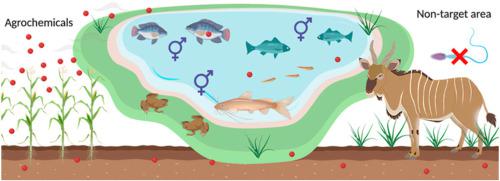Environmental Pollution ( IF 7.6 ) Pub Date : 2020-09-24 , DOI: 10.1016/j.envpol.2020.115718 Ilzé Horak 1 , Suranie Horn 1 , Rialet Pieters 1

|
South Africa is the largest agrochemical user in sub-Saharan Africa, with over 3 000 registered pesticide products. Although they reduce crop losses, these chemicals reach non-target aquatic environments via leaching, spray drift or run-off. In this review, attention is paid to legacy and current-use pesticides reported in literature for the freshwater environment of South Africa and to the extent these are linked to endocrine disruption. Although banned, residues of many legacy organochlorine pesticides (endosulfan and dichlorodiphenyltrichloroethane (DDT)) are still detected in South African watercourses and wildlife. Several current-use pesticides (triazine herbicides, glyphosate-based herbicides, 2,4-dichlorophenoxyacetic acid (2,4-D) and chlorpyrifos) have also been reported. Agrochemicals can interfere with normal hormone function of non-target organism leading to various endocrine disrupting (ED) effects: intersex, reduced spermatogenesis, asymmetric urogenital papillae, testicular lesions and infertile eggs. Although studies investigating the occurrence of agrochemicals and/or ED effects in freshwater aquatic environments in South Africa have increased, few studies determined both the levels of agricultural pesticides present and associated ED effects. The majority of studies conducted are either laboratory-based employing in vitro or in vivo bioassays to determine ED effects of agrochemicals or studies that investigate environmental concentrations of pesticides. However, a combined approach of bioassays and chemical screening will provide a more comprehensive overview of agrochemical pollution of water systems in South Africa and the risks associated with long-term chronic exposure.
中文翻译:

淡水系统中的农用化学品及其作为内分泌干扰化学品的潜力:南非背景
南非是撒哈拉以南非洲地区最大的农用化学品用户,拥有 3000 多种注册农药产品。尽管它们减少了作物损失,但这些化学品会通过浸出、喷雾漂移或径流进入非目标水生环境。在这篇综述中,关注了文献中报道的有关南非淡水环境的遗留和当前使用的杀虫剂,以及这些杀虫剂与内分泌干扰的关联程度。尽管已被禁止,但在南非的水道和野生动物中仍然检测到许多遗留有机氯杀虫剂(硫丹和二氯二苯基三氯乙烷 (DDT))的残留物。还报告了几种当前使用的杀虫剂(三嗪类除草剂、草甘膦类除草剂、2,4-二氯苯氧乙酸 (2,4-D) 和毒死蜱)。农用化学品会干扰非目标生物体的正常激素功能,导致各种内分泌干扰 (ED) 效应:双性、精子生成减少、泌尿生殖乳头不对称、睾丸病变和不育卵。尽管调查南非淡水水生环境中农用化学品和/或 ED 影响的研究有所增加,但很少有研究确定农药的存在水平和相关的 ED 影响。进行的大多数研究要么是基于实验室的,要么是采用 尽管调查南非淡水水生环境中农用化学品和/或 ED 影响的研究有所增加,但很少有研究确定农药的存在水平和相关的 ED 影响。进行的大多数研究要么是基于实验室的,要么是采用 尽管调查南非淡水水生环境中农用化学品和/或 ED 影响的研究有所增加,但很少有研究确定农药的存在水平和相关的 ED 影响。进行的大多数研究要么是基于实验室的,要么是采用体外或体内生物测定以确定农用化学品的 ED 效应或研究杀虫剂的环境浓度。然而,生物测定和化学筛选相结合的方法将更全面地概述南非水系统的农用化学品污染以及与长期慢性接触相关的风险。











































 京公网安备 11010802027423号
京公网安备 11010802027423号